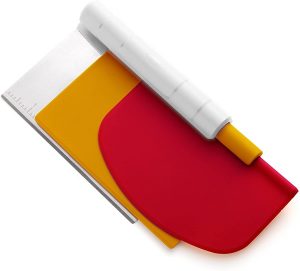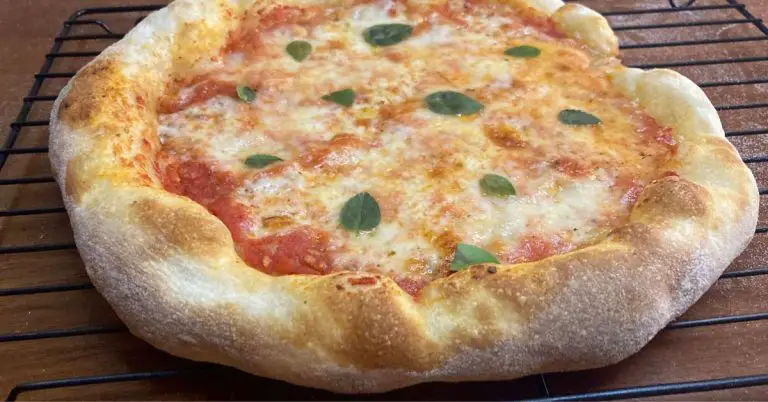Top 10 Biggest Pizza Dough-Making Mistakes
Do you struggle with making great homemade pizza dough? Does it never turn out the way you hope it will?
If so, it’s probably because you’re making common, simple pizza dough making mistakes that are easy to fix.
And you’re in luck, too, because I’ve complied a list of the most common dough making mistakes that beginners usually make.
I make great pizza dough multiple times per week. I’ve made all the mistakes on this list as I learned to perfect my recipe/method (find that method here!).
I’ve complied everything I’ve learned below, so you can save your time and money and learn from my dough making mistakes!

Related Post: How to fix hard pizza crust
Dough Mistake #1: You’re Not Using A Scale
A digital scale is an absolute essential item when making pizza dough, or any kind of dough for that matter.
Baking is much more of a science than cooking is. Cooking is all about taste and personal preferences, so you can usually be a bit loose with your ingredients.
Baking (and therefore making dough), on the other hand, requires very precise measurements in order to get the desired results. Adding 1.0235 cups of flour when the recipe called for 1 can mess things up more than you’d expect.
And maybe you can get away with being a little ‘off’ when making chocolate chip cookies, but trust me: pizza dough requires strict compliance to the recipe.
Accuracy of measurements can be the difference between a light fluffy pizza crust and a flat, dense cracker-like pizza crust. So get yourself a digital scale (they’re not too expensive) before you try another dough.
Once I finally got a digital scale, not only were my pizzas much better, but I also found myself using it way more than I expected, outside of making dough. Now I can’t image living without it!
(Find other kitchen tools I find useful when making pizza here).
Mistake #2: You’re Adding Too Much Flour
Making dough is a messy task. Sometimes as you’re kneading the dough it can feel like you’re playing with a pile of mud that’s more water than anything else.
It’s tempting to keep adding more flour to your little pile of mud, but don’t! Adding more flour will only make your dough heavier and more dense, which means it will dry out quickly in the oven.
Instead, embrace the mess and simply knead longer. Kneading can sometimes take 15-20 minutes before the gluten in the dough fully forms to create a cohesive ball (you read that right – it’s a lot of work!).
So plug in a podcast and get ready to spend some time kneading your pizza dough into perfection.
Or better yet, opt for a no-knead dough (see my recipe here) and let time do the messy work for you as it sits overnight.
Mistake #3: You’re Not Using A Dough Scraper
This is an add-on to mistake # 2. Most people don’t own a dough scraper because they’ve never heard of one. But it’s another cheap and essential tool for anyone who works with dough (see all my tools for making the perfect pizza at home here).
Basically, a dough scraper acts like an extra hand that’s more able to scrape and keep sticky bits of dough off the counter. It makes it easier to push wet flour back into your dough balls.

I use my dough scraper all the time when working with dough, especially when it’s extra wet and sticky. It’s makes the kneading process easier, cleaner and quicker.
Mistake #4: You’re Adding Water To An Already Formed Dough Ball
If you’ve ever kneaded your dough to completion and formed it into a ball only to realize it’s too dry, don’t be tempted to add water.
When you add water to a formed dough ball, you’re breaking up the gluten that you worked so hard to form. All you’re doing it making a wet mess.
If your dough is too dry, you’re better off ditching the dough (or finding another use for it), and starting over.
I love a wet dough and find they make the best pizzas (see how I make mine here), so be sure you add the water at the beginning! (And get that dough scraper out if you don’t like working with wet dough!).
Mistake #5: You’re Adding Flour To Your Finished Dough Ball
Once you’ve finished making your dough ball, it’s logical to think that coating it in flour will keep it from sticking to the inside of your bowl while it settles. But your dough will just absorb this extra flour, which negates the whole point of adding it.
Adding flour to your dough ball will also change the hydration level of the dough, potentially making for a drier crust.
So in my experience, it’s best to simply add a small amount of oil to your bowl to prevent sticking.
Mistake #6: You’re Adding All Your Flour At Once
If you’re following a recipe that calls for 300g of flour, you might think it’s OK to dump it all into your liquids at once. But that’s actually a big mistake.
Not only will dumping your flour in make it harder to get it to mix into all the liquid completely, it also won’t allow for proper oxygenation. And proper oxygenation is essential for a fluffy and delicious crust.
Instead, add flour slowly as you mix. I usually start with about a third of the flour and mix that in. Then I add about another third, and another.
Mistake #7: Your Water Is Too Hot
We all know yeast likes a warm and wet environment, but water that’s too hot will kill it.
Water that’s too warm can also cause your yeast to grow too quickly and over-proof.
Over-proofed dough will be weak and deflate when cooked, leaving your pizza crust flat and dense.
Instead, opt for room temperature water.
Mistake #8: You’re Using Water That’s Too Cold
This is the other end of of the spectrum from using water that’s too hot.
Unlike hot water which will kill your yeast or cause it to grow too fast, water that’s too cold will stunt its growth so that your dough won’t proof properly.
Like with my previous tip, use a water that’s room temperature for optimal growth and a delicious pizza crust.
Mistake #9: You’re Not Covering Your Dough Completely
When you’re done kneading your dough and forming your dough ball, you might have been told to simply put a towel over the bowl and let it proof. This is a big mistake.
A towel is not nearly air-tight enough to keep in the oxygen you need for the dough-proofing process to take place. Using just a towel will also likely cause your dough to dry out as moisture escapes.
In the future, make sure you’re using cling wrap to cover your mixing bowl, or keep it in some other kind of air-tight container as it proofs.
Mistake #10: You’re Adding Something Like Milk Or Soda To Your Dough
This is a bizarre mistake but unfortunately I’ve seen it too many times across the internet.
Please do not add any liquids to your dough other than water.
People seem to think that various kinds of soda will add flavor and sugar to help “feed” the yeast. This is a myth, as the refined sugar in soda is not appropriate for feeding yeast.
I’ve also seen milk added to dough as a way to make it softer. This is also a myth—if you want a lighter and fluffier crust, simply add more water to your recipe to increase the hydration level.
So that’s it! The 10 biggest pizza dough mistakes. Thankfully, they’re all really easy to fix. If you’d like more help with your pizza dough, be sure to check out my method for making it at home and my recipe for Neapolitan pizza is another great one.
Otherwise, Buon Appetito!






